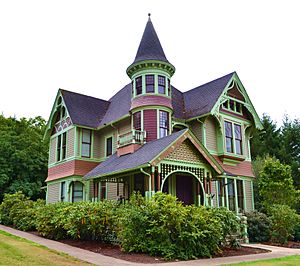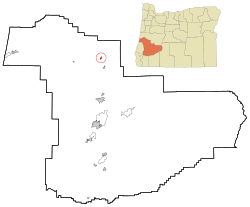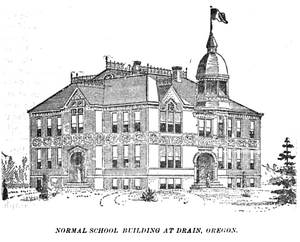Drain, Oregon facts for kids
Quick facts for kids
Drain, Oregon
|
|
|---|---|

|
|
| Motto(s):
Gateway to the Pacific
|
|

Location in Oregon
|
|
| Country | United States |
| State | Oregon |
| County | Douglas |
| Incorporated | 1887 |
| Area | |
| • Total | 0.63 sq mi (1.64 km2) |
| • Land | 0.63 sq mi (1.64 km2) |
| • Water | 0.00 sq mi (0.00 km2) |
| Elevation | 289 ft (88 m) |
| Population
(2020)
|
|
| • Total | 1,172 |
| • Density | 1,851.50/sq mi (714.73/km2) |
| Time zone | UTC−8 (Pacific) |
| • Summer (DST) | UTC−7 (Pacific) |
| ZIP code |
97435
|
| Area code(s) | 541 |
| FIPS code | 41-20500 |
| GNIS feature ID | 2410354 |
| Website | www.cityofdrain.org |
Drain is a small city located in Douglas County, Oregon, in the United States. In 2010, about 1,151 people lived there. The city is named after Charles J. Drain. He was a politician and an important person in the town's early days. In 1871, he gave 60 acres of his land to the Oregon and California Railroad.
Contents
History of Drain
Drain became an official city in 1887. It was an important stop for travelers and goods. In 1876, a special road for coaches was built between Drain and Scottsburg. This made travel easier.
The Drain Normal School
A school called the Drain Normal School opened in 1883. The Methodist Church started this school. A "Normal School" was a place where people learned how to become teachers.
In 1885, the state of Oregon took over the school. They renamed it the Central Oregon State Normal School. It helped train many teachers for the region. The school closed its doors in June 1908.
Geography and Climate
Drain covers an area of about 0.61 square miles (1.6 square kilometers). All of this area is land. The city is located where two main roads meet: Oregon Route 99 and Oregon Route 38. It sits in a pass within the Coast Range. This location is on the way to the Pacific Ocean.
Two creeks, Elk Creek and Pass Creek, meet in Drain. Both of these creeks flow into the Umpqua River.
Pass Creek Bridge
There is a historic covered bridge called Pass Creek Bridge in a park. It is located behind the Drain Civic Center. This bridge used to be for cars, but in 1987, it was moved to the park. Now, only people walking can use it. In 2014, the bridge was closed because some of its wood supports were rotting.
Weather in Drain
Drain has a Mediterranean climate (called Köppen Csb). This means it has dry summers. Summer mornings are cool, but afternoons can be hot. Winters are chilly and wet.
Sometimes in winter, very cold air comes from inland. This can bring frost to Drain. However, Drain does not get much snow. The record for the most snow in one month was in January 1950. It was about 21.9 inches (56 cm). The coldest temperature ever recorded was 0°F (–18°C) in January 1962.
Winters usually have a lot of rain. The wettest month on record was December 1955. It had about 21.93 inches (557 mm) of rain.
Summers are usually hot and clear during the day. Nights are cool. Sometimes, it can get very hot. The highest temperature ever recorded was 109°F (43°C) in July 2015.
| Climate data for Drain, Oregon (1991–2020 normals, extremes 1902–present) | |||||||||||||
|---|---|---|---|---|---|---|---|---|---|---|---|---|---|
| Month | Jan | Feb | Mar | Apr | May | Jun | Jul | Aug | Sep | Oct | Nov | Dec | Year |
| Record high °F (°C) | 73 (23) |
79 (26) |
86 (30) |
95 (35) |
103 (39) |
112 (44) |
109 (43) |
107 (42) |
106 (41) |
96 (36) |
77 (25) |
75 (24) |
112 (44) |
| Mean daily maximum °F (°C) | 50.5 (10.3) |
54.5 (12.5) |
59.0 (15.0) |
63.7 (17.6) |
70.7 (21.5) |
76.1 (24.5) |
84.8 (29.3) |
85.7 (29.8) |
80.3 (26.8) |
67.8 (19.9) |
55.3 (12.9) |
48.8 (9.3) |
66.4 (19.1) |
| Daily mean °F (°C) | 42.6 (5.9) |
44.8 (7.1) |
47.8 (8.8) |
51.5 (10.8) |
57.2 (14.0) |
62.0 (16.7) |
68.1 (20.1) |
68.2 (20.1) |
63.3 (17.4) |
54.8 (12.7) |
46.9 (8.3) |
41.8 (5.4) |
54.1 (12.3) |
| Mean daily minimum °F (°C) | 34.8 (1.6) |
35.1 (1.7) |
36.5 (2.5) |
39.3 (4.1) |
43.8 (6.6) |
47.9 (8.8) |
51.5 (10.8) |
50.7 (10.4) |
46.2 (7.9) |
41.7 (5.4) |
38.6 (3.7) |
34.9 (1.6) |
41.7 (5.4) |
| Record low °F (°C) | 0 (−18) |
4 (−16) |
18 (−8) |
22 (−6) |
25 (−4) |
31 (−1) |
34 (1) |
30 (−1) |
25 (−4) |
16 (−9) |
12 (−11) |
1 (−17) |
0 (−18) |
| Average precipitation inches (mm) | 7.31 (186) |
5.49 (139) |
5.44 (138) |
4.25 (108) |
2.69 (68) |
1.24 (31) |
0.33 (8.4) |
0.42 (11) |
1.42 (36) |
3.51 (89) |
6.96 (177) |
8.54 (217) |
47.60 (1,209) |
| Average snowfall inches (cm) | 0.0 (0.0) |
0.0 (0.0) |
0.0 (0.0) |
0.0 (0.0) |
0.0 (0.0) |
0.0 (0.0) |
0.0 (0.0) |
0.0 (0.0) |
0.0 (0.0) |
0.0 (0.0) |
0.0 (0.0) |
0.0 (0.0) |
0.0 (0.0) |
| Average precipitation days (≥ 0.01 in) | 19.9 | 17.0 | 19.4 | 14.3 | 12.0 | 8.0 | 2.4 | 2.5 | 6.0 | 13.4 | 20.0 | 20.1 | 158.0 |
| Average snowy days (≥ 0.1 in) | 0.3 | 0.1 | 0.0 | 0.0 | 0.0 | 0.0 | 0.0 | 0.0 | 0.0 | 0.0 | 0.1 | 0.2 | 0.7 |
| Source: NOAA | |||||||||||||
People in Drain
| Historical population | |||
|---|---|---|---|
| Census | Pop. | %± | |
| 1880 | 188 | — | |
| 1900 | 193 | — | |
| 1910 | 335 | 73.6% | |
| 1920 | 607 | 81.2% | |
| 1930 | 497 | −18.1% | |
| 1940 | 597 | 20.1% | |
| 1950 | 1,150 | 92.6% | |
| 1960 | 1,052 | −8.5% | |
| 1970 | 1,204 | 14.4% | |
| 1980 | 1,148 | −4.7% | |
| 1990 | 1,011 | −11.9% | |
| 2000 | 1,021 | 1.0% | |
| 2010 | 1,151 | 12.7% | |
| 2020 | 1,172 | 1.8% | |
| U.S. Decennial Census | |||
The United States Census Bureau collects information about people living in cities. This helps us understand how communities are growing and changing.
Drain's Population in 2010
According to the census from 2010, 1,151 people lived in Drain. There were 454 households, which are groups of people living together. Most of the people living in Drain were White (92.9%). A small number were Native American (2.7%) or from other backgrounds. About 4.4% of the population was Hispanic or Latino.
About 33.7% of households had children under 18 living with them. The average household had about 2.54 people. The average age of people in Drain was 39.5 years old. About 25.4% of the residents were under 18. About 16.4% were 65 years old or older.
See also
 In Spanish: Drain (Oregón) para niños
In Spanish: Drain (Oregón) para niños


